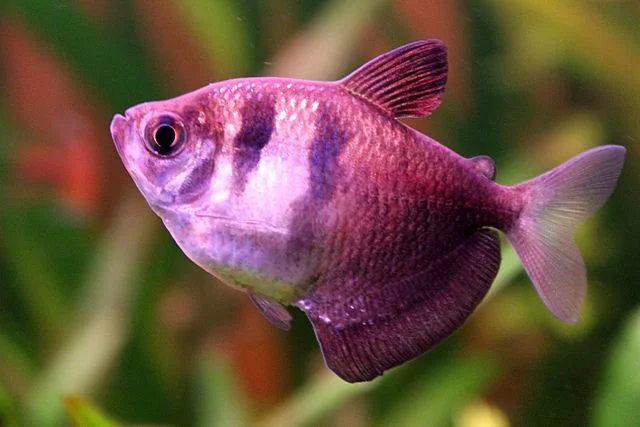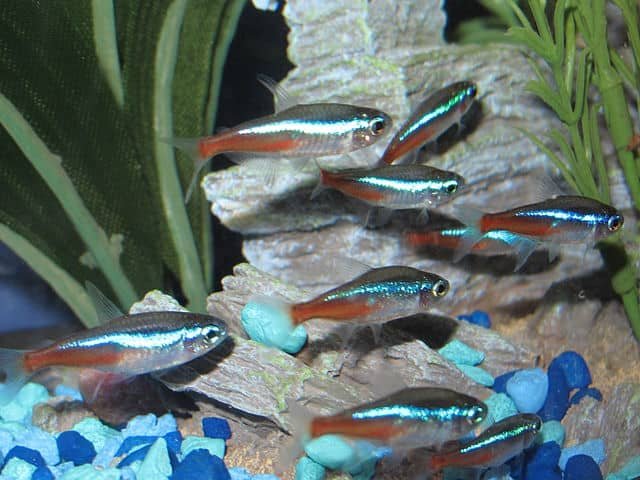
The Rummy-nose Tetra (Hemigrammus bleheri) is a freshwater fish native to South America, known for its beauty and peaceful behavior. Currently, Rummy-Nose Tetras are found in almost all ornamental fish stores worldwide, with prices ranging from US$2.5 to 5.0, depending on their characteristics.
The distinctive red noses and silver bodies of Rummy-Nose Tetras make them a popular choice among aquarium enthusiasts worldwide because they are relatively easy to care for and adapt well to a variety of planted aquarium conditions.
On the other hand, Rummy-Nose Tetras have been used in research laboratories worldwide so that scientists can study and understand the behavior of fish shoals under different environmental conditions.
In this comprehensive guide, we will provide you with all the information you need to care for Rummy-Nose Tetras:
Taxonomy and Characteristics of Rummy-Nose Tetra
- 1 Taxonomy and Characteristics of Rummy-Nose Tetra
- 2 Types of Rummy-Nose Tetras
- 3 Natural Habitat of the Rummy-Nose Tetra
- 4 Care for the Rummy-Nose Tetra
- 5 Feeding of Rummy-nose Tetras
- 6 Aquarium Habitat and Decoration
- 7 Behavior and Compatibility of Rummy-nose Tetras
- 8 Reproduction of Rummy-nose Tetras
- 9 Common Diseases of Rummy-nose Tetras
- 10 Conclusion
- 11 References
- 12 Entradas relacionadas:
- Kingdom: Animalia
- Phylum: Chordata
- Class: Actinopterygii
- Subclass: Neopterygii
- Infraclass: Teleostei
- Superorder: Ostariophysi
- Order: Characiformes
- Family: Characidae
- Genus: Petitella
- Species: Petitella rhodostoma
- Synonym: Hemigrammus rhodostomus
- Common name in Spanish: Pez borrachito, Pez tetra nariz de borracho, Tetra borracho, Tetra de nariz roja.
- English name: Rummy-Nose Tetras, Firehead tetra.
Rummy-nose tetras can reach 4 to 5 cm and can live up to 6 years as long as they are provided with the best breeding conditions. Drunken Tetras have an elongated and streamlined body with a silvery color and a bright red line running along their back from head to tail, and a red spot on the nose that gives them their characteristic name. The coloration is more intense in males.
Types of Rummy-Nose Tetras
In ornamental fish stores, you can find three species of Rummy-Nose Tetras sold as Drunken Tetras. However, the true Rummy-nose Tetra is Petitella rhodostoma (formerly Hemigrammus rhodostomus). The following table provides the main differences:
Table 01. Differences between the different types of Rummy-Nose Tetras marketed in ornamental fish stores.
| Scientific Name | Synonym | Common Name | Characteristics | Natural Habitat |
|---|---|---|---|---|
| Petitella rhodostoma | Hemigrammus rhodostomus | Rummy-Nose Tetra | True Drunken Tetra. Red nose and striped tail. | Brazil (Rio Negro), Colombia, and Venezuela |
| Petitella bleheri | Hemigrammus bleheri | Firehead Tetra or Bright-Nosed Drunken Tetra | Redder head and gill plate. | Amazon basin in Colombia, Brazil, and Peru |
| Petitella georgiae | – | False-Nosed Tetra | Central black stripe on tail extends to halfway down the body, resembling a short, horizontal line. | Amazon basin in Brazil and Peru |
Recently, Bittencourt et al., (2020), based on molecular studies, proposed transferring the Rummy-nose Tetras H. bleheri and H. rhodostomus to the genus Petitella; thus, the new scientific names are P. bleheri and P. rhodostoma, respectively.
Stay Always Informed
Join our communities to instantly receive the most important news, reports, and analysis from the aquaculture industry.


Natural Habitat of the Rummy-Nose Tetra
The three species of Rummy-Nose Tetras inhabit the Amazon basin, specifically the Negro and Meta rivers, which have soft, acidic water with humic acid content (resulting from leaf decomposition).
Care for the Rummy-Nose Tetra
The breeding and care conditions for the three types of Rummy-nose Tetras are similar. In Table 02, you can find a data sheet describing the main water quality parameters and breeding conditions you should provide for your fish.
Table 02. Data sheet of parameters for the care of Rummy-nose Tetras.
| Parameter | Range |
|---|---|
| Aquarium Size | 80 liters or more |
| Water Temperature | 24 to 28°C |
| pH | 6.0 to 7.0 |
| Water Hardness | Prefer soft to slightly hard water, with a general hardness (GH) between 5 and 12 dGH |
| Nitrates | < 20 ppm |
| Water Change | 20-25% of aquarium water every two weeks. |
The Rummy-nose Tetras serves as a good biological indicator of water quality conditions in an aquarium. These fish may become pale or exhibit changes in behavior when nitrate levels exceed critical values.
Feeding of Rummy-nose Tetras
In their natural habitat, Rummy-nose Tetras are omnivorous, feeding on microcrustaceans, filamentous algae, chironomids, and plant matter (dos Anjos et al., 2017). In captivity, replicate their diet by offering a combination of high-quality flake foods, frozen or live foods such as bloodworms, brine shrimp, and plant matter. Ensure proper feeding frequency and avoid overfeeding, which can lead to water quality and fish health issues.
- Types of Food: They can be fed a varied diet of high-quality flakes, small pellets, frozen foods such as brine shrimp and daphnia, and occasionally fresh vegetables like cucumber or zucchini.
- Feeding Frequency: It is recommended to feed them twice a day with small amounts of food.
- Avoid Overfeeding: Overfeeding can cause health problems in fish.
Aquarium Habitat and Decoration
- Substrate: Fine sand or small gravel substrate is recommended.
- Plants: Plants are essential for providing shelter and security to the fish. It is recommended that aquariums for Drunken Tetras have abundant vegetation of species such as Cabomba and Myriophyllum.
- Decorations: Rocks, wood, and other decorative elements can be added to create a natural environment. However, consideration should be given to the behavior of the fish. Lafoux (2023) concludes that spatial constraints influence the collective behavior configuration of Hemigrammus rhodostomus.
- Lighting: Moderate lighting is recommended. Light intensity plays an important role in the behavior of Drunken Tetras.
Behavior and Compatibility of Rummy-nose Tetras
- Social Behavior: Rummy-nose Tetras are peaceful and sociable fish that live in shoals; therefore, they should be kept in groups of 6 or more individuals. An interesting aspect is that the shoal of Hemigrammus rhodostomus exhibits different dynamics depending on the lighting of their habitat (Thiria et al., 2022). In this regard, Lafoux (2023) reports that in an unlit aquarium, a shoal of around 50 Rummy-nose Tetras could not swim in a coordinated manner; as the light intensity gradually increases, the group of Rummy-nose Tetras goes through different phases of behavior.
- Compatible Species: Rummy-nose Tetras are ideal for community aquariums and are compatible with other peaceful fish of similar size, such as neon tetras, danios, rasboras, mollies, platies, ancistrus, cardinal tetras, and guppies.
- Incompatible Species: They are not compatible with aggressive or territorial fish such as bettas.
Reproduction of Rummy-nose Tetras
Understanding the reproductive behavior of Rummy-nose Tetras is essential for aquarists looking to successfully breed these captivating fish. In their natural habitat, Rummy-nose Tetras exhibit typical egg-scattering behavior, where females release eggs that are externally fertilized by males. To encourage breeding in captivity, replicate their natural habitat by providing abundant vegetation and soft, acidic water conditions. Dim lighting and a slight decrease in water temperature can also stimulate spawning behavior.
Below are the main aspects of Rummy-nose Tetra reproduction.
- Sexual Differences: Female Rummy-nose Tetra are slightly larger than males and have a more bulging abdomen. Dos Anjos et al. (2017) reported that the first sexual maturation (L50) was estimated at 2.8 cm for females and 2.6 cm for males of Hemigrammus bleheri.
- Conditions for Reproduction: A breeding aquarium with soft, slightly acidic water and a temperature of 26-28°C, which should be gradually raised to 32°C, is required. In addition to low lighting. Female Rummy-nose Tetra have multiple spawnings with oocytes ranging from 0.06 to 0.66 mm in diameter and fecundity between 101 and 721 oocytes (dos Anjos et al., 2017).
- Egg Hatching: Fertile Rummy-nose Tetra eggs take approximately 72 to 96 hours to hatch at 32°C. The fry spend another 24 to 48 hours absorbing the yolk sac, after which they begin to swim freely.
- Fry Care: The fry are very small and need to be fed live foods such as infusoria and brine shrimp nauplii for at least three weeks due to the slow growth of these fish.
Common Diseases of Rummy-nose Tetras
Bacterial
- Fin Rot: It is a bacterial infection that affects the fish’s fins.
Parasitic
Internal and external parasites can cause various health problems in fish.
Ichthyophthirius multifiliis or Ich: It is a parasitic disease characterized by the appearance of small white spots on the fish’s body.
Nurfatimah (2001) reported the presence of the ectoparasite Gyrodactylus in exports of Rummy-nose Tetras from fish farmers in Jakarta.
Fungal
Fungal infections can affect the fish’s skin and gills.
Conclusion
The Rummy-nose Tetra, is a beautiful and easy-to-care-for freshwater fish that can be a great addition to any aquarium. With the information provided in this comprehensive guide, you can provide these fish with the necessary care to thrive in your aquarium.
By understanding the care needs of Drunken Tetras, exploring different types, and ensuring compatibility with other fish, you can create a thriving aquatic community that brings joy and fascination to your home. Whether you are a beginner or an experienced hobbyist, these beautiful fish are sure to delight and inspire you in the years to come.
References
Bittencourt PS, Machado VN, Marshall BG, Hrbek T, Farias IPF. Phylogenetic relationships of the neon tetras Paracheirodon spp. (Characiformes: Characidae: Stethaprioninae), including comments on Petitella georgiae and Hemigrammus bleheri. Neotrop Ichthyol. 2020; 18(2):e190109. https://doi.org/10.1590/1982-0224-2019-0109
dos Anjos, H. D. B., Yamamoto, K. C., & Magalhães, E. R. S. (2017). Biologia reprodutiva e hábitos alimentares do rodóstomo (Hemigrammus bleheri) um peixe ornamental da Bacia do Médio Rio Negro, Estado do Amazonas, Brasil. Boletim do Instituto de Pesca, 43(1), 65Ã-77.
Lafoux, B. (2023). Collective fish swimming in altered environment (Doctoral dissertation, Université Paris Cité).
Nurfatimah, A. 2001. Inventarisasi Parasit pada Ikan Hias Koral Platy (X~ pho~ uho~ muasc ulatzcs), Ikan Gupi Kobra (Poecilia reticzclaiu), Ikan Red Nose Tetra (Hemigrammzcs rhodosfo~~ izcsd) an Ikan Serpe Minor (Hyphessoblycoi~ serpue) yang dilalulintaskan melalui Balai Karantina Ikan Bandara Soekamo-Hatta, Jakafia (Doctoral dissertation, IPB (Bogor Agricultural University).
Thiria, B., Lafoux, B., & Godoy-Diana, R. (2022). Order in fish collective motion is modified by environnement illuminance. In APS March Meeting Abstracts (Vol. 2022, pp. Y11-007).
Editor at the digital magazine AquaHoy. He holds a degree in Aquaculture Biology from the National University of Santa (UNS) and a Master’s degree in Science and Innovation Management from the Polytechnic University of Valencia, with postgraduate diplomas in Business Innovation and Innovation Management. He possesses extensive experience in the aquaculture and fisheries sector, having led the Fisheries Innovation Unit of the National Program for Innovation in Fisheries and Aquaculture (PNIPA). He has served as a senior consultant in technology watch, an innovation project formulator and advisor, and a lecturer at UNS. He is a member of the Peruvian College of Biologists and was recognized by the World Aquaculture Society (WAS) in 2016 for his contribution to aquaculture.




